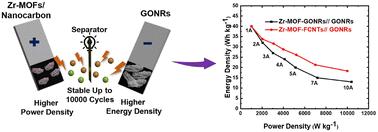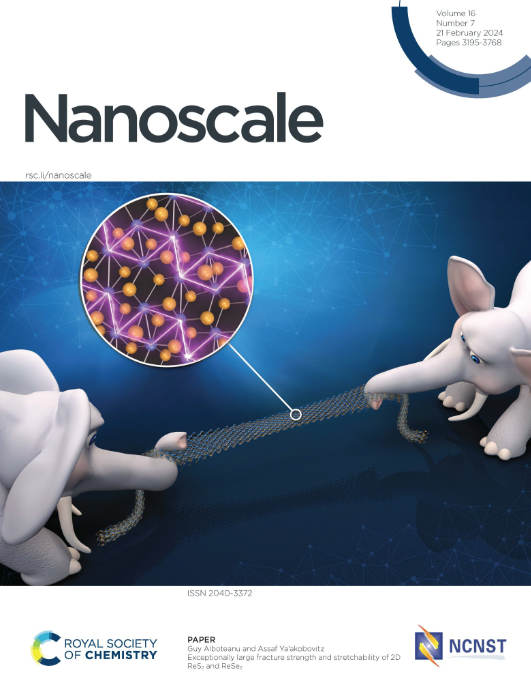Zr-MOF composites with zipped and unzipped carbon nanotubes for high-performance electrochemical supercapacitors
IF 5.8
3区 材料科学
Q1 CHEMISTRY, MULTIDISCIPLINARY
引用次数: 0
Abstract
Metal–organic frameworks (MOFs) have gained considerable interest as crystalline porous materials with notable characteristics, such as high surface area and excellent electrochemical performance, particularly in supercapacitor applications. The combination of MOFs with various nanocarbon materials further enhances their performance. This study investigated the combination of zirconium-based MOFs (Zr-MOFs) with graphene oxide nanoribbons (GONRs), zipped carbon nanotubes, and functionalized carbon nanotubes (FCNTs) to fabricate composites with elevated electrical conductivity, adjustable surface area, chemical robustness, mechanical strength, and customizable attributes for specific applications. Zr-MOFs exhibit remarkable capacitance, making them promising electrode materials for supercapacitors. GONRs and FCNTs have recently emerged as focal materials owing to their unique properties, which make them promising materials for electrochemical energy storage devices. A thorough investigation of the supercapacitive behavior of GONRs, FCNTs, Zr-MOFs, Zr-MOFs/FCNTs, and Zr-MOFs/GONRs in 1 M H2SO4 using different evaluation systems (three- and two-electrode systems) revealed a significant enhancement in the capacitance of Zr-MOFs after the introduction of GONRs and FCNTs. Employing Zr-MOF/GONR and Zr-MOF/FCNT composites as positive electrodes and GONRs as negative electrodes in two-electrode measurements demonstrated remarkable cycling stability by retaining their specific capacitances (Cs) even after 10 000 consecutive charge/discharge cycles at a high current density of 10 A g−1. Moreover, they feature a broad potential window of 1.7 V in the three-electrode system. This extends to 2 V in the two-electrode system, achieving high Cs. This highlights the remarkable electrochemical performance of the Zr-MOF/GONR and Zr-MOF/FCNT composites, offering a compelling approach for energy storage applications.

用于高性能电化学超级电容器的带拉链和不带拉链碳纳米管 Zr-MOF 复合材料
金属有机框架(MOFs)作为一种结晶多孔材料,具有高比表面积和优异的电化学性能等显著特点,尤其是在超级电容器应用方面,已经引起了人们的极大兴趣。将 MOFs 与各种纳米碳材料结合可进一步提高其性能。本研究调查了锆基 MOFs(Zr-MOFs)与氧化石墨烯纳米带(GONRs)、拉链碳纳米管和功能化碳纳米管(FCNTs)的结合,以制造具有高导电性、可调表面积、化学稳定性、机械强度和可定制属性的复合材料,用于特定应用。Zr-MOFs 具有显著的电容特性,因此有望成为超级电容器的电极材料。最近,GONRs 和 FCNTs 因其独特的性能而成为焦点材料,这使它们成为电化学储能设备的理想材料。利用不同的评估系统(三电极系统和双电极系统)对 GONRs、FCNTs、Zr-MOFs、Zr-MOFs/FCNTs 和 Zr-MOFs/GONRs 在 1 M H2SO4 中的超级电容行为进行的深入研究表明,在引入 GONRs 和 FCNTs 后,Zr-MOFs 的电容显著增强。在双电极测量中,将 Zr-MOF/GONR 和 Zr-MOF/FCNT 复合材料用作正电极,GONRs 用作负电极,即使在 10 A g-1 的高电流密度下连续充放电 10,000 次,也能保持其比电容 (Cs),显示出显著的循环稳定性。此外,在三电极系统中,它们还具有 1.7 V 的宽电位窗口。在双电极系统中,电位窗口扩展到 2 V,实现了高 Cs。这凸显了 Zr-MOF/GONR 和 Zr-MOF/FCNT 复合材料卓越的电化学性能,为能量存储应用提供了一种引人注目的方法。
本文章由计算机程序翻译,如有差异,请以英文原文为准。
求助全文
约1分钟内获得全文
求助全文
来源期刊

Nanoscale
CHEMISTRY, MULTIDISCIPLINARY-NANOSCIENCE & NANOTECHNOLOGY
CiteScore
12.10
自引率
3.00%
发文量
1628
审稿时长
1.6 months
期刊介绍:
Nanoscale is a high-impact international journal, publishing high-quality research across nanoscience and nanotechnology. Nanoscale publishes a full mix of research articles on experimental and theoretical work, including reviews, communications, and full papers.Highly interdisciplinary, this journal appeals to scientists, researchers and professionals interested in nanoscience and nanotechnology, quantum materials and quantum technology, including the areas of physics, chemistry, biology, medicine, materials, energy/environment, information technology, detection science, healthcare and drug discovery, and electronics.
 求助内容:
求助内容: 应助结果提醒方式:
应助结果提醒方式:


